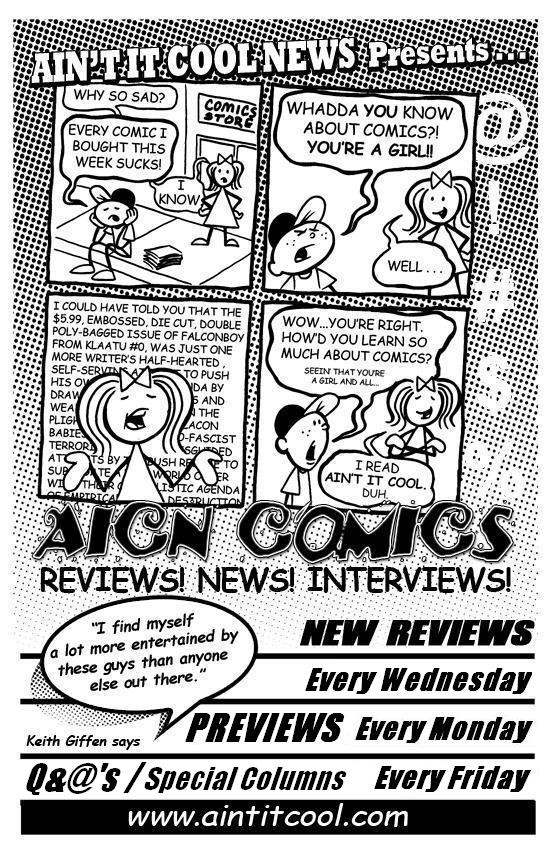@@@@ What the #$%! is AICN COMICS: Q&@? @@@@
AICN COMICS: Q&@ is our new semi-weekly interview column where some of your favorite @$$Holes interview comic bookdom’s biggest, brightest, newest, and oldest stars. Enjoy this latest in-depth interview filled with @$$y goodness and be sure to look for more AICN COMICS as we gaze into the future of comics every week with AICN COMICS: SPINNER RACK PREVIEWS every Monday and then join the rest of your favorite @$$Holes for their opinions on the weekly pull every Wednesday with AICN COMICS REVIEWS!
Q’s by Matt Adler!
@’s by GREENDALE artist Cliff Chaing!
Hey folks, Ambush Bug here. Just flew back from SDCC and boy are my Thanagarian wings tired….
Ba-Dump-Derrrrrrr…
Anyway, I’ll have con reports, interviews, panel reports, shitty pics, and other tidbits from SDCC starting tomorrow and beyond. But I need a day of rest, so fortunately, while I was douching about at SDCC, the rest of the Holes weren’t resting on their laurels or even resting with someone named Laurel (got I’m tired). Magnificent Matt Adler has an cool interview to tide you over. Sleepy time now. Take it away, Matt!
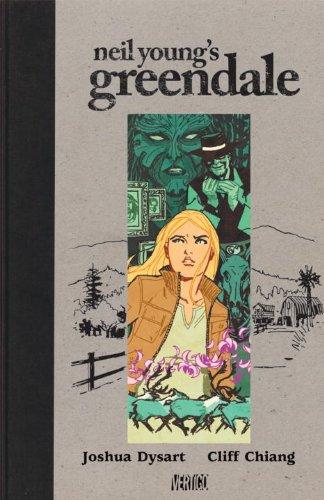 Matt Adler here again, this time with an interview with artist Cliff Chiang. Cliff’s latest project is Neil Young’s GREENDALE, an original graphic novel from Vertigo, written by Josh Dysart in collaboration with legendary singer/songwriter Neil Young. I spoke with Cliff to learn more about the book, and what it was like bringing Neil’s vision to graphic novel form. Enjoy!
Matt Adler here again, this time with an interview with artist Cliff Chiang. Cliff’s latest project is Neil Young’s GREENDALE, an original graphic novel from Vertigo, written by Josh Dysart in collaboration with legendary singer/songwriter Neil Young. I spoke with Cliff to learn more about the book, and what it was like bringing Neil’s vision to graphic novel form. Enjoy!
MATT ADLER (MA): How did you get involved with GREENDALE?
CLIFF CHIANG (CC): It’s kind of a funny story. They [Vertigo] had sent Neil Young a bunch of samples of different artists, and I’ve worked with our editor Karen Berger before, so she sent a sample of some of my recent work to Neil, and he really liked it. He picked it out of a bunch of like, 10 or 12 samples. And it seemed like he really had his heart set on me doing it, because they asked me if I was interested and I was actually busy on another project, so I had to turn down GREENDALE.
MA: What were you working on at the time?
CC: I was about to work on DOCTOR THIRTEEN, with Brian Azzarello.
MA: So this was 2006?
CC: Yeah, this would be like early 2006. So I had to turn it down, and I figured they’d find somebody no problem; with such a big project like that, I thought it’d be easy to fill the spot. But then I got a call about 6 months later, as I was finishing up DOCTOR THIRTEEN, and Karen was asking me if I’d be able to consider it again. And actually I was already booked on GREEN ARROW AND BLACK CANARY. So I couldn’t do it. But she said, “Neil really wants you, he said you’re the guy for it.” I said “Well, that’s really flattering but I can’t do it.” And I think about a year later maybe, after GREEN ARROW was all wrapped up, and I was actually looking around for a project to do, and it was Super Bowl Sunday, and I got an email kind of randomly in my inbox saying “This is an email for Cliff. Is there any way you’d consider doing GREENDALE? I know you’re busy, but maybe next year; DC is about to start on it, and I’d really like to have you on board. Thanks, NY.” And I was so out of it that it took me a second to figure out that NY was Neil. He had tracked me down through my website to ask me, so at that point I knew I had to take it. I wasn’t working on anything else; I read a script and I really liked this human quality to it, so I just felt like I had to do it. And knowing that Neil had waited this whole time to get me was also a big factor.
MA: The script was all done by that point?
CC: Yeah, the script was all written.
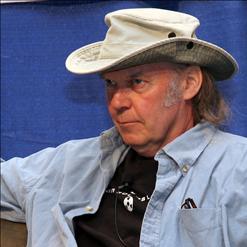
MA: Do you know why Neil wanted to bring GREENDALE to the graphic novel form?
CC: Not specifically. I think he had always intended for there to be a supernatural twist to the proceedings, you know? Like the characters had always been intended to have powers of nature and things like that. They just weren’t very explicit on the album. They’re there, but the level to which he had conceived of them in his head was a lot stronger and more, I guess for lack of a better term, comic-booky. And you know he’s a comic book fan from way back…
MA: Oh, he is? He reads them regularly?
CC: I don’t know if he reads current stuff but I know he was a fan of stuff in the ‘60s and ‘70s. And GREENDALE is a story that’s so close to him, that he’s been trying to get out in different forms; it came out first as a CD, and then he did his film, and I think it was last year, they did a musical of it in New York. So he’s been trying to get the story out there, and you clearly see it’s something he wants people to experience in one way or another.
MA: What kind of collaboration have you had between you, Josh, and Neil?
CC: I know Josh and Neil have had a lot of contact; I actually haven’t had that much contact with Neil at all. The fact is, they worked together on the script; Josh would send him drafts, and then he’d come back with notes, and trying to make sure that everything was to his liking before we started on the art. They were very careful, and did a great job of nailing everything down before I started drawing. Because once I’m drawing, it’s a lot more difficult to change things. So once I got the script, I realized there wasn’t a lot to talk about. We sent pages and character designs to Neil very early on, and he liked them. He responded really enthusiastically. And as soon as we got on more of a roll, we realized we didn’t need to send him batches of 5 pages or 10 pages. We ended up doing 30 and 50 page batches by the end. It was exactly what he had wanted from the project, so he really didn’t have any comments for me whatsoever, and no changes, so it was a really smooth process.
MA: Did you help in deciding how to translate the story into graphic terms?
CC: Yes and no. A lot of the heavy lifting story-wise was done by Josh, trying to pull together all these disparate threads. The “Greendale” album is not really very linear, but he managed to pull out a through-line for this, following Sun Green. And once he gave me the script, it was really up to me to try and figure out visually what the best way would be to bring some of these things to life. There were a couple of parts that were maybe a little too quiet, and you have to go in and add a little bit more visual flair to it, just knowing that you’re playing within the conventions of comics, and people were probably expecting a little bit more otherworldliness to it. And knowing that this was all part of Neil’s vision from the get-go also made it a lot easier. We didn’t want to be just kind of tarting up his story to make it feel more palatable to a comics audience. And he actually wanted to push things even further than what we had in the story.
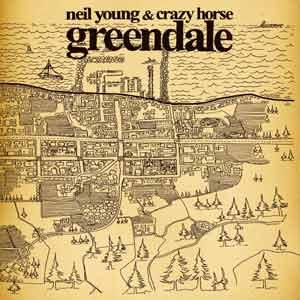
MA: And Vertigo’s a good place to do that, right?
CC: Yeah, yeah. I think we struck a good balance; there were some things that Neil wanted that were very kind of super-heroey, and we were able to pull back on that, but still keep the flavor of it.
MA: Did your approach to illustrating this differ a lot from your past projects?
CC: In some ways. I knew that Neil was responding to a certain look in the artwork, and I also knew that because of his fans, that we had an opportunity to bring this book to a much wider audience than the usual Wednesday comics crowd. So in that sense I tried to keep the storytelling and the drawing as accessible as possible; there weren’t a lot of tricky layouts and panel compositions that were more advanced, that you need to be more familiar with comics in order to parse it out. With GREENDALE, I really tried to keep it as no-nonsense as possible when it came to that stuff, really just make it a book that anyone could pick up and read. And I think it also fit with the tone of the story as well. It was such a kind of small town tale that getting fancy with that kind of thing probably wouldn’t have been in the spirit of the book.
MA: Did you have to do a lot of research for this project?
CC: Yeah. I live in New York, and the book takes place in Northern California, so there were a bunch of things I needed to look at to get a feel for what the town would be like or for various set pieces in the book. At one point they’re on a fishing boat, and then they’re back on the ranch, or they’re in the backyard where there’s a chicken coop, stuff like that. So I had to do research and figure out how some of that stuff worked, what would be an appropriate fishing boat, and how do you go about gutting a fish. These are things that I like to go into, just to give a little bit more authenticity to the story. You can make that stuff up, but it usually lacks a narrative weight when you’re reading it. You just know when things are kind of fake. But when there are little details that feel like they’re observed, it makes a huge difference in the reading of the story and the experience of it.
MA: How much of the previous “Greendale” material, in terms of the album, and the film, and so on, have you looked at for this, and what did you think of it?
CC: I listened to the album, and I looked at the art book that came out around the same time, and I watched the film, so I tried to familiarize myself with the material as much as I could, but at the same time I didn’t want to be too influenced by it. As much as this project comes from Neil, it was also coming from Josh and myself, so we wanted to make sure our voices were in there, and I wasn’t just trying to parrot back something that I’d seen in the movie or in the book. So there were slight changes to the characters, and what they look like, and the family tree, and things like that.
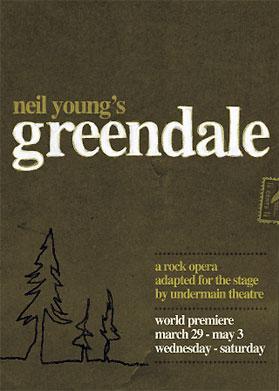
MA: Have you listened to much of Neil’s music before working on this project?
CC: I was familiar with his music before; I think probably everybody has heard Neil’s music, albums like “Harvest” and “After The Gold Rush”; they’re such classic rock albums, I don’t think you can really call yourself a music fan without knowing Neil’s music, so I was familiar with it on that level, but I wasn’t like a superfan where I listened to every album and gone to all the live shows and stuff like that. I know Josh really grew up listening to Neil, and our editor Karen is also just a huge Neil fan. So I knew that they were covering that angle of it. I was familiar enough, and I read biographies and stuff like that to try and give me more information, but I didn’t feel like I had necessarily had to delve into all of his work in order to do the best job on the book.
MA: Can you tell us a little bit about how you developed the visuals for some of the key characters in the book, like Sun, Jed, and The Stranger?
CC: Sun just needs to be this really kind of pure vision. She’s this blond girl, she used to be a cheerleader, but she’s kind of more and more disaffected with high school; she’s about to graduate, and she finds that she’s unhappy with a lot of the way things are going in the world. It takes place in 2003 right before our invasion of Iraq, so there’s a lot of political turmoil at the time as well, and she’s trying to process all that stuff. So with her design, I really tried to keep her as simple as possible.
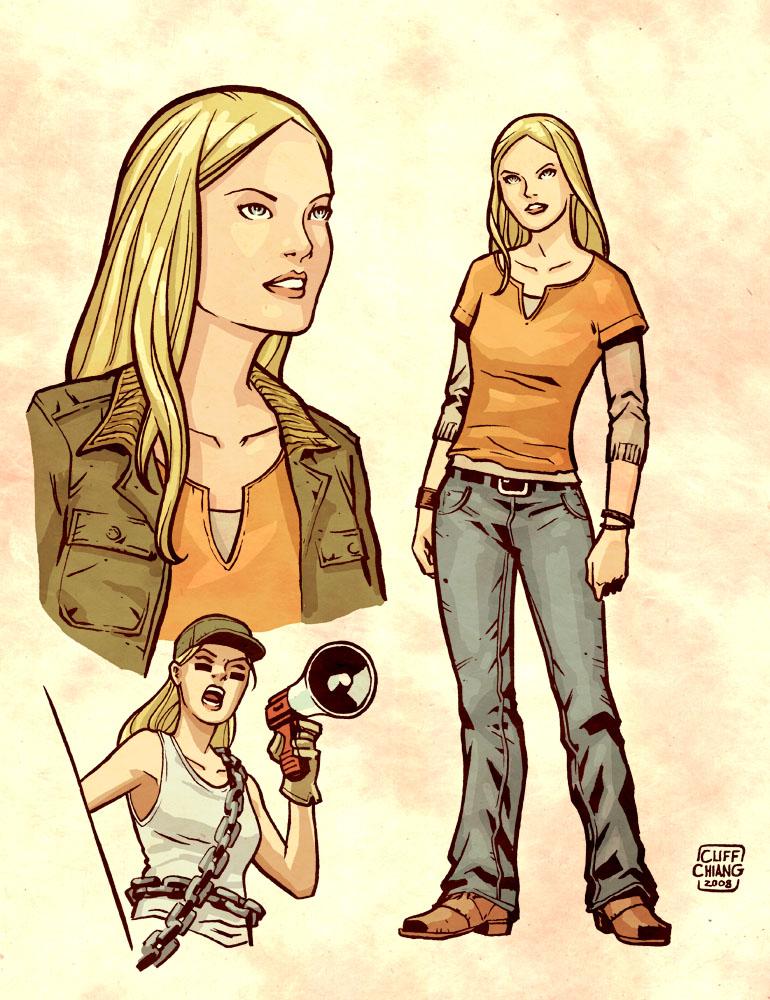
MA: She’s like the girl next door.
CC: Yeah, that’s really her appeal. And I didn’t want to do anything too out there, too distinctive with her, because she’s also a character that you’re supposed to relate to, and anything that was going to be too distinctive would also be a point of departure from having this kind of everygirl personality. We particularly wanted young readers to be able to read it and sort of empathize with her and maybe see themselves being drawn to political action or just taking a stance one way or another.
MA: Was that one of Neil’s goals with the project?
CC: I don’t know. That was something that Josh and I had spoken about. We had said to each other, if we do this right, maybe this will have an effect on someone who’s in high school right now. Maybe they’ll read it and think twice about what they’re doing, and what they believe. And if we did that, then our job is really done. So I tried to keep her as girl next door and friendly and pretty…in some ways, almost a blank slate for you to project onto. With Jed and The Stranger, Josh had come up with the idea of some of the characters resembling Neil Young, which I thought was really kind of fun. I didn’t want to do a straight up photo reference of Neil because I thought that would be kind of distracting, but they take on aspects of Neil’s history. So Jed looks like a really young Neil from the late ‘60s, early ‘70s, down to the really long sideburns, and these really kind of piercing, slightly droopy eyes. You’re trying to capture some of that vulnerability that Neil had then too, doing that singer/songwriter stuff. With The Stranger, Neil’s been known to wear these suits and panama hats, so we made him kind of like a darker version of Neil, this kind of oily, greasy person who rolls into town in this ridiculous red country-western blues jacket, snakeskin boots, and dirty black jeans. We really wanted to give him this kind of sinister quality, and it was fun to try to project bits of Neil onto that character, because I think that there are times that Neil can be kind of a trickster as well, so getting that on there was really fun.

MA: You mentioned a bit about the issues that Sun gets involved with, in terms of the Iraq War, and the environment, and I guess one of the major themes of this book, as you said, is the responsibility to take action when you feel strongly about something. Are the views expressed by Sun something you’re in sync with?
CC: The idea I think is regardless of what your politics are, that you should speak out. And really, that’s what Sun does at the end; she finds her voice. I agree with a lot of the politics in GREENDALE, but I tend to be a quieter person about them. I know Josh also agrees with a lot of what’s in GREENDALE. We needed to present the politics of GREENDALE, but we were careful to not be too strident about it; we wanted to present it very plainly but not necessarily be banging the drum, because we felt like it would also take away from the story, and be distracting. So we tried to present the stuff as straight as we could. And if you agree with it, great, if you didn’t, that’s fine. We weren’t banging people over the head with it and turning people off. So ultimately, as political as the book might seem to some, we really wanted to just make it mostly about Sun and her family and this coming of age story.
MA: I’ve heard there’s been some discussion of a follow-up to this; is that something you’re interested in working on? Have you talked about that?
CC: I’m still exhausted from this actually. (laughs) I’ve heard they might be thinking about doing some sequels, and I definitely would be open to talking about it. It was a really incredible experience; I hadn’t worked on anything quite this long and this involved. I’ve worked on projects for longer; I did like 10 or 11 issues of HUMAN TARGET, which works out to be more in page count, but taking on a book from start to finish that is one volume, 150 pages, it’s a completely different creative affair. You have to keep all the story in your head, and you have to be thinking about the reader at all times, and kind of think ahead, and think backwards, and whenever you’re drawing something, you have to think about how it affects things that are coming, and what’s already been drawn. So it was pretty exhausting keeping all that in my head at once. So I definitely would need a break before jumping into a sequel.

MA: Is part of it that with a serial project, there are more sort of natural break points, and this didn’t have that for you?
CC: Yeah. The individual issues of a comic are like chapters, so being able to focus on one chapter at a time, that’s what I’m used to. And doing a long form narrative like GREENDALE was a huge change of pace for me.
MA: Do you think it took you longer than it would have if you had a comparable number of pages in a serial project?
CC: Absolutely. I think when you’re working in monthly comics, you’re always chasing that monthly deadline. And it makes you stop, whereas if you have a longer book, you can kind of noodle things to death, and really keep working, and redraw things. So with GREENDALE, I think because it was such a long book, because the deadline was so far out, and because I knew that we kind of had a bigger platform to reach people than ever before, I kind of psyched myself out in a lot of ways. So I’m happy with the work, but I definitely feel I could have drawn it faster. (laughs)
MA: (laughs) Well Cliff, I really want to thank you for taking the time to talk with me, and answer all my questions.
CC: Sure, no problem.
Matt Adler is a writer/journalist, currently writing for AICN among other outlets. He’s been reading comics for 20 years, writing about them for 7, and spends way, way, too much time thinking about them, which means he really has no choice but to figure out how to make a living out of them. He welcomes all feedback.
Editing, compiling, imaging, coding, logos & cat-wrangling by Ambush Bug
Proofs, co-edits & common sense provided by Sleazy G
Ad by Prof. Challenger

 Matt Adler here again, this time with an interview with artist Cliff Chiang. Cliff’s latest project is Neil Young’s GREENDALE, an original graphic novel from Vertigo, written by Josh Dysart in collaboration with legendary singer/songwriter Neil Young. I spoke with Cliff to learn more about the book, and what it was like bringing Neil’s vision to graphic novel form. Enjoy!
Matt Adler here again, this time with an interview with artist Cliff Chiang. Cliff’s latest project is Neil Young’s GREENDALE, an original graphic novel from Vertigo, written by Josh Dysart in collaboration with legendary singer/songwriter Neil Young. I spoke with Cliff to learn more about the book, and what it was like bringing Neil’s vision to graphic novel form. Enjoy!





